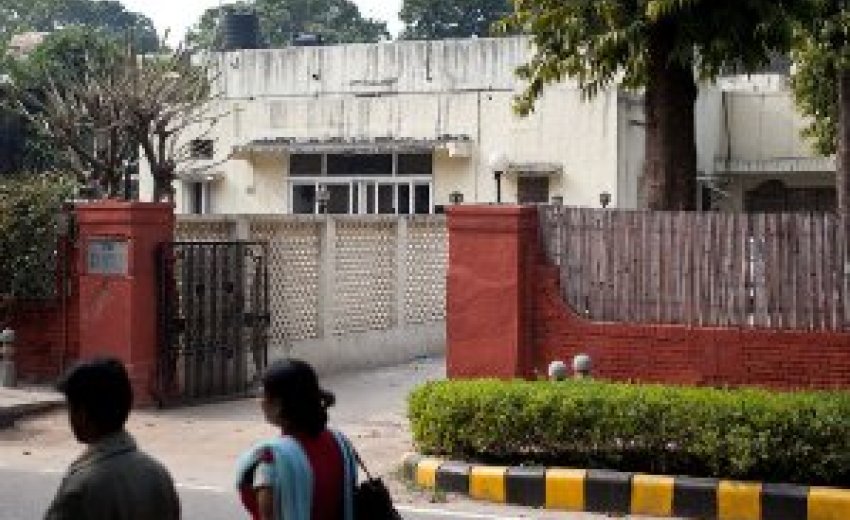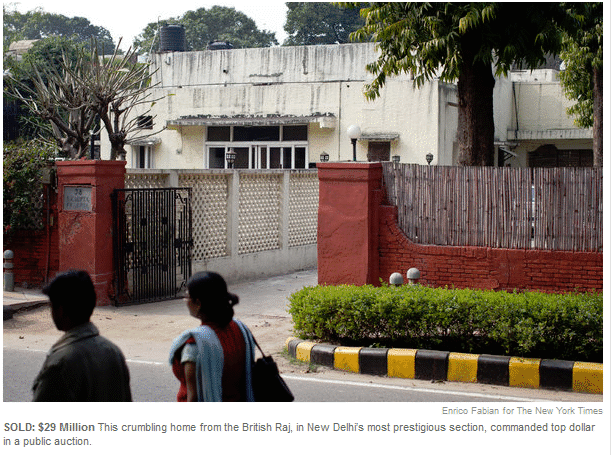 | |
|
March 2, 2013: NEW DELHI — The fading bungalow at 38 Amrita Shergil Marg does not immediately shout real estate bling. There is no tennis court, no infinity pool, no Sub-Zero refrigerator or walk-in closet. The paint is chipped, the bathrooms are musty and the ceilings have water stains. The house may ultimately be torn down. Yet when it went up for public auction, the winning bid was almost $29 million. And many neighbors consider that a bargain. One block away, a gracious if not quite Rockefeller-ready residence once leased by the Mexican ambassador is now reportedly on the market for more than $100 million. Other nearby houses are going for $40 million to $70 million. “The price of the Mexican residence is $110 million,” said Jorge Roza de Oliveira, Portugal’s ambassador to India. “You can buy a home in New York and Miami and Lisbon and London and keep a lot of change for that much.” Real estate prices in the heart of New Delhi, especially for the bungalows built nearly a century ago during the British Raj, are among the highest in the world. Though India’s economy has cooled, the demand for property in elite areas remains so strong that even finding a house for sale is tricky: formal listings do not exist; prices usually circulate by word of mouth. Transactions often require some “black” money, or stacks of cash paid under the table to avoid taxes. The buyers are often Indian industrialists looking for a trophy property, a real estate Rolex. Or, real estate agents and sellers say, they can be politicians or their proxies, who often pay with trunks of cash. For their money, buyers get a lovely piece of land and a piece of history, if not much in the way of amenities. Many houses require a major overhaul. Services, if far better in these elite areas, are still inadequate: drinking the tap water is not advised, and power failures remain an irritant. The obvious question about the prices, in a country where hundreds
of millions of people still live on less than $2 a day, is: Why? [Emphasis ours]
|
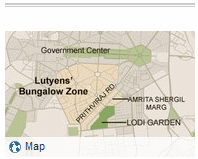 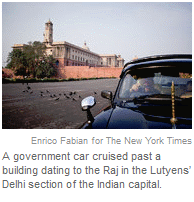 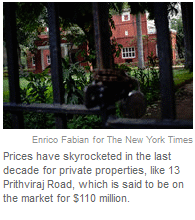 |
|
To a large degree, India is experiencing the sort of real estate boom
common to big, emerging economies. When Japan’s economy was soaring in
the 1980s, prices in Tokyo were so frothy that the 845-acre compound of
the Imperial Palace was valued at more than all the real estate in California. More recently, China has seen a boom, with real estate values rising in some cities by 500 percent.
But the spike in New Delhi is also being fueled by ego, status and some unique distortions in India’s economy. Few properties come available in the leafiest, most prestigious section of the capital, known as Lutyens’ Delhi, because the area is mostly dedicated to government housing. Powerful government ministers live in British-era bungalows with stately lawns of several acres, while lesser officials are eligible for different categories of government housing in an oasis largely separated from the rest of the chaotic capital, where many people live crowded into slums or shanties. “This is the best part of Delhi, the core of Delhi,” said Munish Kumar Garg, who oversees the allocation of government housing. “If these properties in Lutyens’ Delhi were put on sale, there would be a queue two kilometers long.” Mr. Garg, the director of the government’s Directorate of Estates, controls one of the more valuable residential real estate portfolios in the world. Asked how many New Delhi properties fell under his agency, he shrugged. “It would be difficult to know,” he said. “Maybe 10,000.” It was a British architect, Edwin Lutyens, who in the early 1900s designed what is now the governmental heart of the capital. Beyond the grand buildings erected as the seat of British imperial power, Mr. Lutyens and other architects also built a residential bungalow zone of whitewashed single-story homes surrounded by verdant gardens. When India won its independence in 1947, the British moved out of many of the houses and the Indians moved in. Today, power in Delhi can be measured by where a politician lives. The Directorate of Estates divides properties into eight categories, with Category 8 bungalows, the most exclusive, reserved for ministers and other top leaders. Former prime ministers and presidents, and their spouses, are allowed to remain in Category 8 housing until death. Given the shortage of such housing, the recent death of former Prime Minister Inder Kumar Gujral has spurred jockeying over who will get the bungalow. Navin Chawla, who was India’s chief election commissioner from 2005 to 2010, lived with his wife in a Category 8 bungalow on six acres, with accommodation for 17 servants, including a separate house most likely worth many millions of dollars. When his term ended, so did his tenancy. “I have to tell you, these homes are very timeless,” he said, sounding wistful. “It’s a bonus of the job to get a six-acre property for five years, one of the few bonuses of being election commissioner, I can tell you.” Not surprisingly, as Indian industrialists have amassed great fortunes in recent years, the temptation to buy into a zone where status is so nakedly demarcated and only a few hundred private properties exist has proved irresistible. Property values in the Lutyens’ bungalow zone, as well as in nearby neighborhoods, have appreciated steadily for many years but skyrocketed in the past decade. In some cases, families have held these private houses for generations. Many were refugees from Pakistan after partition in 1947, when streets like Amrita Shergil Marg were hardly exclusive. Veena Kumar’s parents arrived almost penniless in 1947 and rented a bungalow on the street for about $5.50 a month, before buying it eight years later. In those days, the house was at the southern rim of the city, beside what is now Lodi Garden, which is known as the city’s most beautiful park but seemed like jungle back then. Longtime neighbors recall hearing the cry of hyenas at night. Now the house lies in the heart of the city and Ms. Kumar and her sister are looking to sell. Ms. Kumar declined to discuss her asking price, but local media reported it as about $55 million. “One cannot afford these taxes,” she said, explaining that the upkeep and property taxes had pushed her to sell. “It is very expensive.” The wild prices have also affected the rental market. For decades, owners happily rented to ambassadors or diplomatic missions. Now, rents have jumped so sharply that some ambassadors are moving. Mr. Oliveira, the Portuguese ambassador, recently relocated after his rent soared. Mexican ambassadors had lived at 13 Prithviraj Road — the house priced at $110 million — for a half-century, with the original lease signed by Octavio Paz, the Nobel Prize-winning writer and poet who was Mexico’s ambassador in the 1960s. (The United States Embassy is a beneficiary of the rising real estate values, because for several decades it has owned several residential properties in elite areas.) Rahul Rewal, a local real estate agent, said that demand was pushing up prices all over the capital region and that the Lutyens’ zone actually was a safe investment, since values keep going up, partly because so few places come onto the market. Fifteen years ago, the telecommunications magnate Sunil Mittal paid about $6.6 million for a property on Amrita Shergil Marg that he razed and rebuilt. At the time, the price was astonishing; today, it would be a bargain. Mr. Mittal’s brother, Rajan, was the winner of the auction for 38 Amrita Shergil Marg. The property had been entangled in a family legal feud for three decades until a judge ordered that the property be sold at auction, with the proceeds divided among family members. Had it been sold privately, many neighbors and brokers say, the final price would have been higher. To avoid taxes, many sellers demand huge, secret cash payments to supplement the publicly recorded selling price. Even now, the owners are still bickering. G. K. Gupta lives in the front half of the house, while his nephew Shivraj Gupta lives with his family in the back half. The uncle is in favor of the sale, but the nephew says he is still challenging it in court. And though both would be wildly rich when the sale is completed, the elder Mr. Gupta said that kind of money only goes so far in New Delhi. “I’ll have to invest it in property,” he said. “And property is very expensive in New Delhi.” | |

